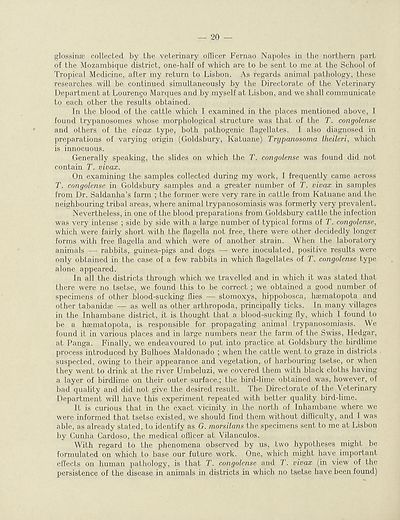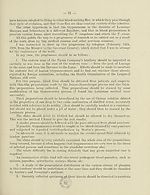Download files
Complete book:
Individual page:
Thumbnail gallery: Grid view | List view

20
glossinse collected by the veterinary officer Fernao Napoles in the northern part
of the Mozambique district, one-half of which are to be sent to me at the School of
Tropical Medicine, after my return to Lisbon. As regards animal pathology, these
researches will be continued simultaneously by the Directorate of the Veterinary
Department at Lourengo Marques and by myself at Lisbon, and we shall communicate
to each other the results obtained.
In the blood of the cattle which I examined in the places mentioned above, I
found trypanosomes whose morphological structure was that of the T. congolense
and others of the vivax type, both pathogenic flagellates. I also diagnosed in
preparations of varying origin (Goldsbury, Katuane) Trypanosoma theileri, which
is innocuous.
Generally speaking, the slides on which the T. congolense was found did not
contain T. vivax.
On examining the samples collected during my work, I frequently came across
T. congolense in Goldsbury samples and a greater number of T. vivax in samples
from Dr. Saldanha’s farm ; the former were very rare in cattle from Katuane and the
neighbouring tribal areas, where animal trypanosomiasis was formerly very prevalent.
Nevertheless, in one of the blood preparations from Goldsbury cattle the infection
was very intense ; side by side with a large number of typical forms of T. congolense,
which were fairly short with the flagella not free, there were other decidedly longer
forms with free flagella and which were of another strain. When the laboratory
animals — rabbits, guinea-pigs and dogs — were inoculated, positive results were
only obtained in the case of a few rabbits in which flagellates of T. congolense type
alone appeared.
In all the districts through which we travelled and in which it was stated that
there were no tsetse, we found this to be correct ; we obtained a good number of
specimens of other blood-sucking flies — stomoxys, hippobosca, hsematopota and
other tabanidae — as well as other arthropoda, principally ticks. In many villages
in the Inhambane district, it is thought that a blood-sucking fly, which I found to
be a heematopota, is responsible for propagating animal trypanosomiasis. We
found it in various places and in large numbers near the farm of the Swiss, Hedgar,
at Panga. Finally, we endeavoured to put into practice at Goldsbury the birdlime
process introduced by Bulhoes Maldonado ; when the cattle went to graze in districts
suspected, owing to their appearance and vegetation, of harbouring tsetse, or when
they went to drink at the river Umbeluzi, we covered them with black cloths having
a layer of birdlime on their outer surface ; the bird-lime obtained was, however, of
bad quality and did not give the desired result. The Directorate of the Veterinary
Department will have this experiment repeated with better quality bird-lime.
It is curious that in the exact vicinity in the north of Inhambane where we
were informed that tsetse existed, we should find them without difficulty, and I was
able, as already stated, to identify as G. morsitans the specimens sent to me at Lisbon
by Gunha Cardoso, the medical officer at Vilanculos.
With regard to the phenomena observed by us, two hypotheses might be
formulated on which to base our future work. One, which might have important
effects on human pathology, is that T. congolense and T. vivax (in view of the
persistence of the disease in animals in districts in which no tsetse have been found)
glossinse collected by the veterinary officer Fernao Napoles in the northern part
of the Mozambique district, one-half of which are to be sent to me at the School of
Tropical Medicine, after my return to Lisbon. As regards animal pathology, these
researches will be continued simultaneously by the Directorate of the Veterinary
Department at Lourengo Marques and by myself at Lisbon, and we shall communicate
to each other the results obtained.
In the blood of the cattle which I examined in the places mentioned above, I
found trypanosomes whose morphological structure was that of the T. congolense
and others of the vivax type, both pathogenic flagellates. I also diagnosed in
preparations of varying origin (Goldsbury, Katuane) Trypanosoma theileri, which
is innocuous.
Generally speaking, the slides on which the T. congolense was found did not
contain T. vivax.
On examining the samples collected during my work, I frequently came across
T. congolense in Goldsbury samples and a greater number of T. vivax in samples
from Dr. Saldanha’s farm ; the former were very rare in cattle from Katuane and the
neighbouring tribal areas, where animal trypanosomiasis was formerly very prevalent.
Nevertheless, in one of the blood preparations from Goldsbury cattle the infection
was very intense ; side by side with a large number of typical forms of T. congolense,
which were fairly short with the flagella not free, there were other decidedly longer
forms with free flagella and which were of another strain. When the laboratory
animals — rabbits, guinea-pigs and dogs — were inoculated, positive results were
only obtained in the case of a few rabbits in which flagellates of T. congolense type
alone appeared.
In all the districts through which we travelled and in which it was stated that
there were no tsetse, we found this to be correct ; we obtained a good number of
specimens of other blood-sucking flies — stomoxys, hippobosca, hsematopota and
other tabanidae — as well as other arthropoda, principally ticks. In many villages
in the Inhambane district, it is thought that a blood-sucking fly, which I found to
be a heematopota, is responsible for propagating animal trypanosomiasis. We
found it in various places and in large numbers near the farm of the Swiss, Hedgar,
at Panga. Finally, we endeavoured to put into practice at Goldsbury the birdlime
process introduced by Bulhoes Maldonado ; when the cattle went to graze in districts
suspected, owing to their appearance and vegetation, of harbouring tsetse, or when
they went to drink at the river Umbeluzi, we covered them with black cloths having
a layer of birdlime on their outer surface ; the bird-lime obtained was, however, of
bad quality and did not give the desired result. The Directorate of the Veterinary
Department will have this experiment repeated with better quality bird-lime.
It is curious that in the exact vicinity in the north of Inhambane where we
were informed that tsetse existed, we should find them without difficulty, and I was
able, as already stated, to identify as G. morsitans the specimens sent to me at Lisbon
by Gunha Cardoso, the medical officer at Vilanculos.
With regard to the phenomena observed by us, two hypotheses might be
formulated on which to base our future work. One, which might have important
effects on human pathology, is that T. congolense and T. vivax (in view of the
persistence of the disease in animals in districts in which no tsetse have been found)
Set display mode to:
![]() Universal Viewer |
Universal Viewer | ![]() Mirador |
Large image | Transcription
Mirador |
Large image | Transcription
Images and transcriptions on this page, including medium image downloads, may be used under the Creative Commons Attribution 4.0 International Licence unless otherwise stated. ![]()
| League of Nations > Health > Investigations on human trypanosomiasis in Mozambique > (22) |
|---|
| Permanent URL | https://digital.nls.uk/191818408 |
|---|
| Shelfmark | LN.III |
|---|---|
| Description | Over 1,200 documents from the non-political organs of the League of Nations that dealt with health, disarmament, economic and financial matters for the duration of the League (1919-1945). Also online are statistical bulletins, essential facts, and an overview of the League by the first Secretary General, Sir Eric Drummond. These items are part of the Official Publications collection at the National Library of Scotland. |
|---|---|
| Additional NLS resources: |
|

